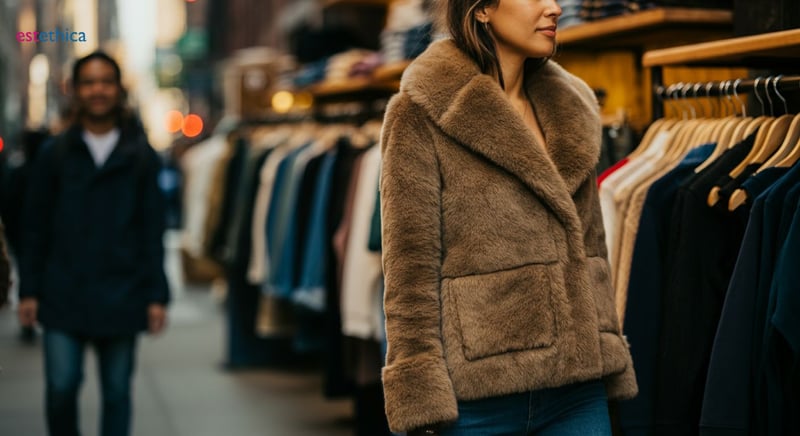estethica Unveiled: Mastering Sustainable Fashion
Master sustainable fashion with insights on eco-friendly materials and ethical brands. Join the green fashion revolution.
The concept of sustainable fashion is gaining momentum worldwide, influenced by a rising consumer demand for environmentally and ethically sound practices. Just as in healthcare, where pioneering technological methods are employed for the betterment of patient care at estethica, the fashion industry is embracing sustainable practices to extend the life cycle of clothing and reduce ecological footprints.
Understanding the Core of Sustainable Fashion
The Essence of Sustainable Fashion
Sustainable fashion is a movement that prioritizes eco-friendly clothing, mindful production, and ethical fashion brands. It seeks to reduce waste and promote transparency, much like the personalized care offered at estethica. This approach balances environmental stewardship with consumer satisfaction, ensuring that fashion choices do not compromise the planet's health.
Key Elements of Sustainable Fashion
- Eco-friendly clothing materials like organic cotton and recycled polyester.
- Ethical fashion brands committed to fair labor practices.
- Innovative production methods that minimize environmental impact.
These elements contribute to a sustainable style that resonates with consumers seeking ethical apparel options. For instance, brands like Patagonia and Stella McCartney have set benchmarks in the industry by integrating sustainable practices into their core operations.
Steps to Embrace Sustainable Fashion
- Research and choose brands that prioritize sustainability.
- Opt for clothing made from sustainable materials.
- Support companies with transparent supply chains.
By following these steps, consumers can make informed choices that align with their values and contribute to a more sustainable future. Understanding what is aesthetics mean in fashion can further enhance the appreciation of sustainable choices.

Eco-Friendly Clothing: A Guide to Materials
Exploring the Best Eco-Friendly Clothing Materials
Eco-friendly clothing materials are pivotal in sustainable fashion, offering both environmental and aesthetic benefits. Organic cotton, for instance, is grown without harmful pesticides, reducing soil and water pollution. Hemp, another sustainable option, requires minimal water and grows rapidly, making it a favorite among ethical fashion brands. Recycled fibers, such as those from plastic bottles, transform waste into wearable art, embodying the essence of green fashion.
- Organic cotton: Reduces pesticide use and promotes soil health.
- Hemp: Grows quickly with minimal resources, ideal for sustainable style.
- Recycled fibers: Converts waste into fashion, supporting a circular economy.
These materials not only contribute to a sustainable style but also align with the aesthetic beauty principles seen in innovative healthcare services at estethica. By choosing eco-friendly clothing, consumers can enjoy fashion that respects both personal health and the planet.
How to Choose Sustainable Fashion
- Identify materials that align with your values, such as organic cotton or hemp.
- Research brands that prioritize eco-friendly practices and ethical production.
- Consider the lifecycle of the clothing, from production to disposal.
Understanding how to choose sustainable fashion involves more than just selecting materials; it requires a commitment to supporting ethical fashion brands. This approach mirrors the dedication to quality and sustainability found in the services offered by the Manchester aesthetics clinic, where non-invasive techniques ensure safe outcomes. By integrating these principles into fashion choices, consumers can contribute to a healthier planet and a more ethical industry.

Navigating Ethical Fashion Brands with Ease
Understanding Ethical Fashion Brand Transparency
Ethical fashion brands are committed to transparency, ensuring consumers are informed about their supply chains. This transparency is akin to the clarity provided by aesthetic beauty clinics, where procedures and outcomes are clearly communicated. Brands like Everlane and People Tree exemplify this by openly sharing their production processes and labor practices, allowing consumers to make responsible choices.
- Everlane: Known for its "Radical Transparency" in pricing and production.
- People Tree: Pioneers in fair trade fashion, ensuring ethical labor practices.
- Patagonia: Advocates for environmental responsibility and transparent supply chains.
These brands not only prioritize ethical practices but also align with the principles of sustainable fashion, offering consumers peace of mind in their purchasing decisions. Understanding what is aesthetics mean in the context of fashion can enhance appreciation for these ethical choices, much like the personalized care at a Manchester aesthetics clinic.
Steps to Identify Ethical Fashion Brands
- Research brand commitments to sustainability and ethical practices.
- Look for certifications like Fair Trade or B Corp status.
- Evaluate transparency in supply chain and production methods.
By following these steps, consumers can confidently navigate the world of ethical fashion brands. This approach mirrors the meticulous selection process in aesthetic beauty treatments, where informed choices lead to optimal outcomes. Embracing ethical fashion not only supports sustainable practices but also contributes to a more transparent and responsible industry.

Embrace the Circular Fashion Economy
The Future of Fashion: Circular Economy
The circular fashion economy is revolutionizing the industry by focusing on resource efficiency and sustainability. This model is akin to the innovative approaches seen in aesthetic beauty clinics, where cutting-edge technology maximizes patient outcomes. By reducing waste and reusing materials, the circular economy supports a sustainable lifestyle and offers a renewed vision for fashion's future.
Key Benefits of the Circular Fashion Economy
- Minimizes environmental impact through resource efficiency.
- Promotes sustainable fashion by extending the lifecycle of clothing.
- Encourages innovation in eco-friendly clothing materials.
These benefits align with the principles of sustainable fashion, offering consumers a way to engage with ethical fashion brands that prioritize environmental responsibility. The circular economy not only enhances sustainable style but also reflects the aesthetic beauty found in nature, much like the personalized care at a Manchester aesthetics clinic.
Steps to Participate in the Circular Fashion Economy
- Choose clothing made from recycled or upcycled materials.
- Support brands that implement circular practices in their production.
- Engage in clothing swaps or second-hand shopping to reduce waste.
By following these steps, consumers can actively participate in the circular fashion economy, contributing to a more sustainable and ethical industry. This approach mirrors the dedication to sustainability seen in the services offered by aesthetic beauty clinics, where innovative techniques ensure optimal outcomes. Embracing the circular economy not only supports eco-friendly clothing but also aligns with the broader goals of sustainable fashion.
Innovative Sustainable Fashion Practices
Embracing the Circular Fashion Economy
Frequently Asked Questions
What is sustainable fashion and why is it important?
How can I choose sustainable fashion?
What are the best eco-friendly clothing materials?
How do ethical fashion brands ensure transparency?
What is the circular fashion economy and how can I participate?
Discover the path to your healthiest and most beautiful self with estethica's award-winning services. Contact us today for a free consultation and experience the highest standards of care and innovation in healthcare.
📞 Call Now for Your Free Consultation